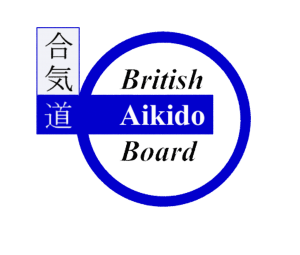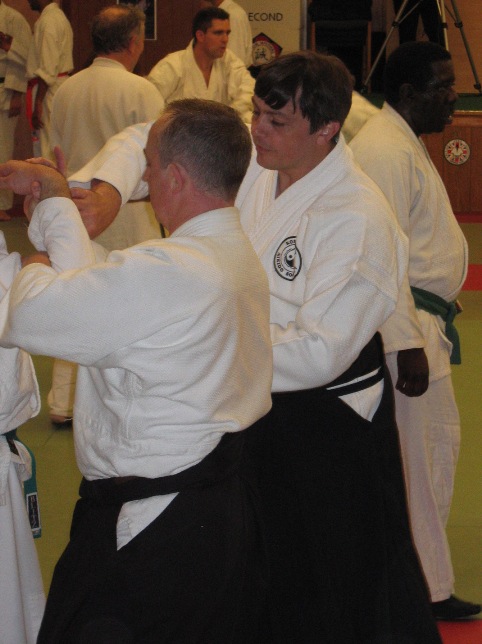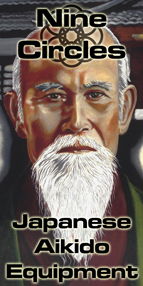History of Aikido

Aikido’s founder, Morihei Ueshiba, was born in Japan on December 14, 1883. As a boy, he often saw local thugs beat up his father for political reasons. He set out to make himself strong so that he could take revenge. He devoted himself to hard physical conditioning and eventually to the practice of martial arts, receiving certificates of mastery in several styles of jujitsu, fencing, and spear fighting. In spite of his impressive physical and martial capabilities, however, he felt very dissatisfied. He began delving into religions in hopes of finding a deeper significance to life, all the while continuing to pursue his studies of budo, or the martial arts. By combining his martial training with his religious and political ideologies, he created the modern martial art of Aikido. Ueshiba decided on the name Aikido in 1942 (before that he called his martial art aikibudo and aikinomichi).
On the technical side, Aikido is rooted in several styles of jujitsu (from which modern judo is also derived), in particular daitoryu-(aiki)jujitsu, as well as sword and spear fighting arts.
Over simplifying somewhat, we may say that Aikido takes the joint locks and throws from jujitsu and combines them with the body movements of sword and spear fighting. However, we must also realize that many Aikido techniques are the result of Master Ueshiba’s own innovation.
On the religious side, Ueshiba was a devotee of one of Japan’s so-called new religions, Omotokyo. Omotokyo was (and is) part neo-shintoism, and part socio-political idealism. One goal of omotokyo has been the unification of all humanity in a single heavenly kingdom on earth where all religions would be united under the banner of omotokyo. It is impossible sufficiently to understand many of O Sensei’s writings and sayings without keeping the influence of Omotokyo firmly in mind.
Despite what many people think or claim, there is no unified philosophy of Aikido. What there is, instead, is a disorganized and only partially coherent collection of religious, ethical, and metaphysical beliefs which are only more or less shared by Aikidoists, and which are either transmitted by word of mouth or found in scattered publications about Aikido.
There is still insufficient data available, concerning the full history of Aikido and its origins, and while more will, no doubt be discovered, the following is a brief outline of what has been learned to date.
The Rise and Fall of the Imperial System (4th-12th Century AD)
Japanese History is the embodiment of Imperial History. Its story begins with the Yamato race which established itself in a small province in central Imperial Japan during the 4th century. In the course of about the next 300 years, the Yamato family gradually gained control over the numerous warring tribes and clans in the surrounding provinces.
It was by way of trade connections with Korea and China (under the Han Dynasty) that Japan gained the political and cultural foundation upon which Japanese culture was built. However, as cultural contact with China was interrupted towards the end of the 9th century, Japanese civilization began to take on its own special characteristics and form. Life in the capital was marked by great elegance and refinement. While the court gave itself up to the pursuits of the arts and social pleasures, its authority over martial clans in the provinces became increasingly uncertain.
Effective control passed into the hands of two rival families, the Minamoto and the Taira, who both traced their descent from previous Emperors. The Minamoto finally prevailed, annihilating the Taira clan in 1185. This Minamoto victory marked the end of the Imperial Throne as the effective political power in Japan, and the beginning of seven centuries of feudal rule.
The Feudal Age And The Samurai
At the onset of the feudal age, the Samurai were peasant farmers who fought for their Lords as well as they could when the occasion arose. As conflict between landlords became more frequent, it became necessary to train armed groups to protect the respective boundaries. At this time, these armed groups were called Samurai or Bushi, but their status in society was not established until a military government was formed by the Minamoto family in 1192. This military government (the Shogunate) encouraged austerity and the pursuit of martial arts and related disciplines for the Samurai. These studies were eventually codified and called Bushido – The Way of the Samurai.
Early Development of the Martial Arts (Bugei) 1000AD
As the feudal era advanced, the Samurai came to occupy the uppermost strata of Japanese society. Their principal duty was to learn and practice many martial arts, the skills necessary to fulfil their allegiance to the feudal lord for whom they were expected to fight and die.
There were numerous martial arts which the Bushi were required to learn: Kenjutsu (sword), Bajutsu (horsemanship), Kyujutsu (archery), and Sojtsu (spear) constituted the principal combat arts. A favourite saying among Bushi at that time was ‘Master Eighteen Martial Arts’. Additionally, it was necessary that the Bushi learn a secondary system of combat techniques to support their armed fighting methods. These unarmed techniques were referred to as Kum7iuchi and involved a form of grappling techniques which evolved from Sumo (combat wrestling). Throughout the feudal era, the distinction between armed and unarmed techniques became greater.
Development of Unarmed Techniques and Aiki-Jujutsu
By degrees, unarmed combat techniques developed into different systems and styles (ryu). Varying battlefield situations and the technical requirement of feudal warfare led to the establishment of various ryu which were controlled by, and passed down through, the larger powerful families. One of these systems was Aiki-Jujutsu. It is not completely clear where Aiki techniques originated, but it is said to have originated with Prince Tei Jun, the 6th son of the Emperor Selwa (850-880), and passed on to succeeding generations of the Minamoto family. By the time the art reached Shinra Saburo Yoshimitsu, the younger brother of Yishite Minamoto, it seems that the foundations of modern Aikido had already been laid.
Yoshimitsu was a man of exceptional learning and skill, and it is said that he devised much of his technique by watching a spider skilfully trap a large insect in its fragile web. His house, Daito mansion has given its name to his system of Aiki-Jujutsu which came to be called Daito Ryu Aiki-Jujutsu.
Yoshimitsu’s second son lived in Takeda, in the province of Kai, and his family became known by the name Takeda. Subsequently, the techniques of Daito Ryu were passed on to successive generations as secret techniques of the Tekeda house and were made known only to family members and retainers. When Kunitsugu Takeda moved to Aizu in 1574, the technique came to be known as Aizu-todome (secret techniques).
During the 16th century, Japan was embroiled in civil wars. Each feudal Lord (Daimyo) struggled to maintain a powerful, independent position within the country. In order to do so, each Daimyo had to create a stable, unified force of his own, which required a very strong bond between the lord and his Bushi. Bushido, the code of the Samurai, encouraged the development of combat techniques; cultivated the qualities of justice, benevolence, politeness and honour; and above all inculcated the idea of supreme loyalty to lord and cause. It was during this period of independence and feudal isolation that combat forms developed into numerous ryu.
Aiki-Jujutsu and its Social Background
The next two and a half centuries (Tokugawa period) were relatively peaceful for Japan. Though they continued to practice, the Samurai as a class, saw little combat, and refined the various martial arts of Kenjutsu, Iai jutsu, Bajutsu, and forms of Jujutsu. Ju is a Chinese word meaning pliable, harmonious, adaptable or yielding, Jutsu means technique. As a collective term applied to all fighting forms, Jujutsu came into existence long after the forms it describes originated. Jujutsu’s golden age extended from the late 17th century to the mid 19th century.
As the martial arts and all Japanese culture became strongly influenced by Buddhist concepts, the fighting arts were transformed from combat techniques (Bugei) into ways (Budo), inculcating self-discipline, self-perfection and philosophy. The dimensions of the martial arts expanded beyond the simple objective of killing an enemy to include many aspects of everyday living. Particularly after the decline of the Samurai class, the martial techniques became martial ways and great emphasis was placed upon the study of Budo as a means of generating the moral strength necessary to build a strong and vital society.
At the time, Aikido was known by many names, and remained an exclusively Samurai practice handed down within the Takeda family until Japan emerged from isolation in the Meiji period. The Meiji Revolution (1868) brought not only the return of Imperial supremacy, but also a westernised cultural, political and economic way of life to Japan.
The Bushi, as a class, virtually disappeared under a new constitution that proclaimed all classes equal, but the essence of Bushido, cultivated for many centuries, continued to play an important part in the daily lives of the Japanese. Budo, being less combative and more concerned with spiritual discipline by which one elevates oneself mentally and physically, was more attractive to the common people of every social strata. Accordingly, Kenjutsu became Kendo, Iai jutsu became Iaido, Jojutsu became Jodo and Jujitsu became Judo.
O-Sensei Morihei Ueshiba: The Founder of Modern Aikido
As a young man, Morihei Ueshiba (born 14th December 1883) had an unusual interest in the martial arts, philosophy and religion. The environment of his youth, one of religious discipline and tradition, had an enormous effect on the course of his later life.
In the year 1898, Ueshiba left his home village outside Osaka and travelled to Tokyo, seeking instruction in the martial arts. He actively investigated dozens of arts, but was eventually drawn to specialize in three: the sword style known as Yagyu Shin-Kageryu, the staff style known as Hozoin-ryu and Tenjin Shinyo Jujutsu.
The Russo-Japanese War (1904) provided Ueshiba with a real situation to develop himself mentally and physically, in accord with the principles he had learned during his martial arts training. Ueshiba the soldier, spent most of the war years in the harsh climate of Northern Manchuria and by the end of the war, his health had deteriorated considerably. With characteristic vigour, he regained his vitality by the way of long hours spent in outdoor labour. Soon, Ueshiba was engaged by the government to lead a group of immigrants to Hokkaido (the Northern Island of Japan).
Another adventurous young man also made the move to Hokkaido, his name was Sokaku Takeda, head of the Takeda family. Ueshiba and Takeda met in 1905 and Ueshiba began his study of Daito Ryu Aiki-Jujutsu under Takeda Sensei. In addition, he continued to practice the other arts he had learned in Tokyo, particularly Kenjutsu and Jojutsu.
Travelling home to visit his ailing father, Ueshiba met Onisaburo Deguchi, leader of the Omotokyo religion. Ueshiba was very impressed with Deguchi and subsequently became one of his disciples. Although his commitment led him to further develop his mind, his martial arts studies were not neglected. In 1925 Ueshiba organized his own style of Aiki Jujutsu, largely for his own spiritual and physical development.
During the next decade, Ueshiba’s students ( Tomiki, Mochizuki, Shioda and others) were active in building a foundation for present day Aikido. Ueshiba, however, was interested in seeking the true martial way, the essential spirit of Budo. In his search he left the dojo to work at farming. Through his closeness with nature and continued training, he tried to unify his spiritual and physical being. In 1950, Ueshiba returned to the Tokyo dojo with a mature, modified art which he then called Aikido.
The evolution of martial arts to ways, Bugei to Budo. Ueshiba diligently applied himself to the reworking of the techniques he had taught, and synthesized them into a form that taught harmony and love rather than violence and decimation. In this way he was able to integrate his spiritual beliefs and his great technical proficiency.
Ueshiba proclaimed that the true Budo way (the way of the warrior) was the way of peaceful reconciliation. He dedicated himself to the design of an art that would teach technical prowess and strength, and commitment to the self-discipline needed for personal growth. He dubbed this new form Aikido.
 O sensi Ueshiba continued to instruct until his death in 1969, earning the respect and admiration of all who met him. Before his death he received a government award as the designer of modern Aikido, and general acclaim for his efforts to bring peace and enlightenment to all. As his concern and energy touched the lives of his students he worked with, several styles of Aikido evolved.
O sensi Ueshiba continued to instruct until his death in 1969, earning the respect and admiration of all who met him. Before his death he received a government award as the designer of modern Aikido, and general acclaim for his efforts to bring peace and enlightenment to all. As his concern and energy touched the lives of his students he worked with, several styles of Aikido evolved.
The most notable of these styles are Yoshinkan, Tomiki, Aikikai and the most recent Shinshin Toitsu. The founders of these styles are all dedicated men committed to the precepts set down by Master Ueshiba. Each has developed certain elements of O Sensei’s teachings, so each style differs from the others while maintaining an essential sameness.
Entering Amazon from here supports the BAB.


